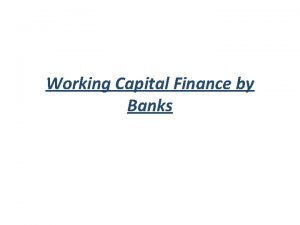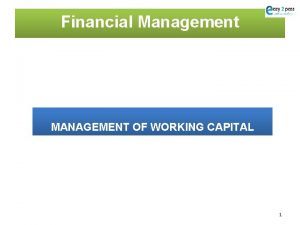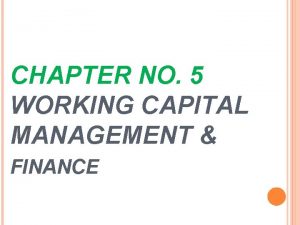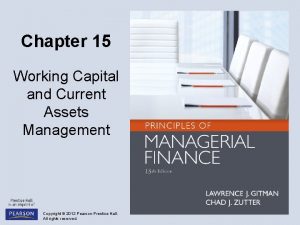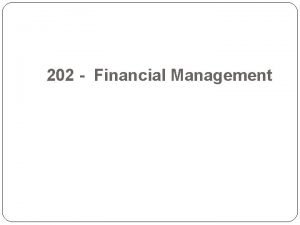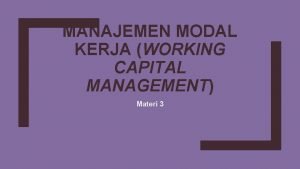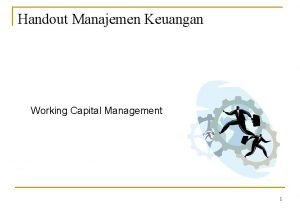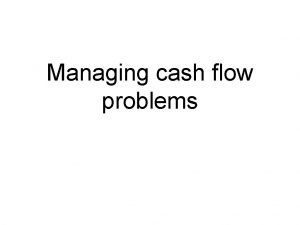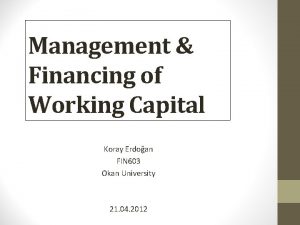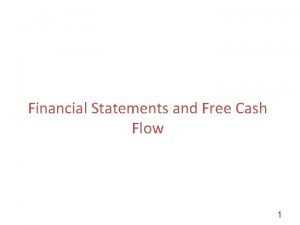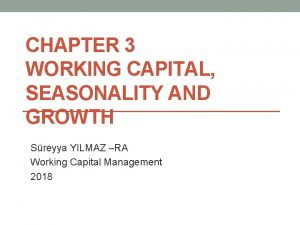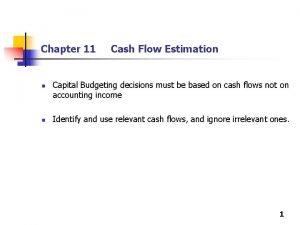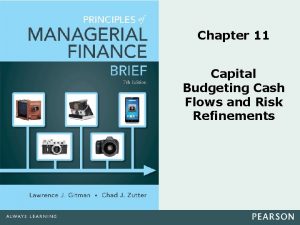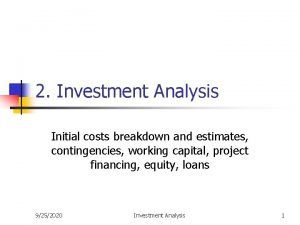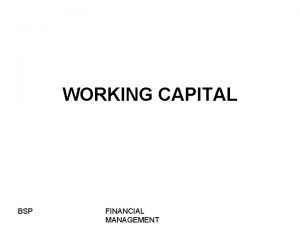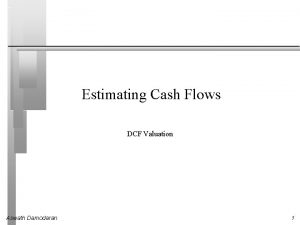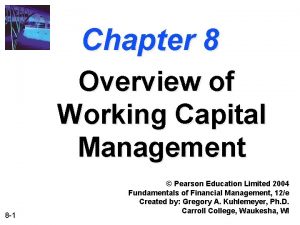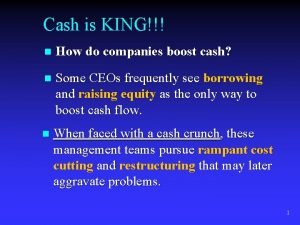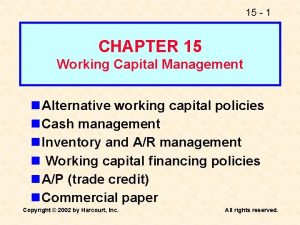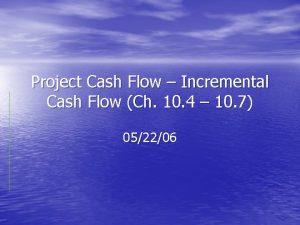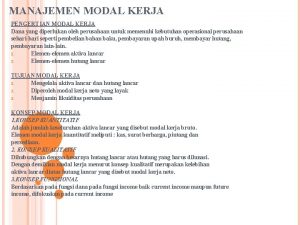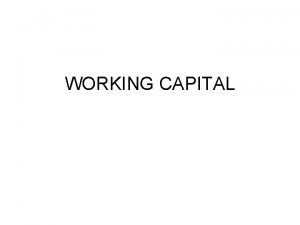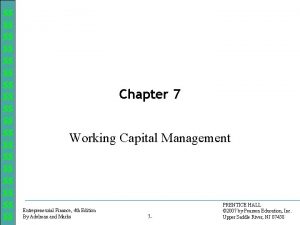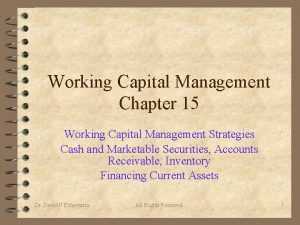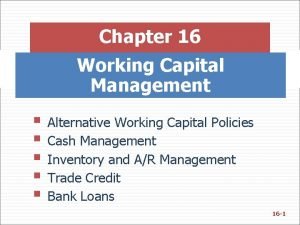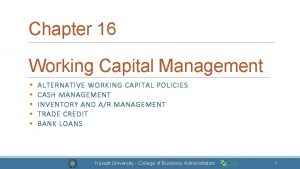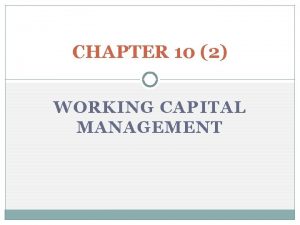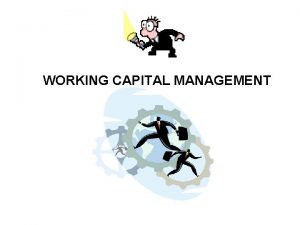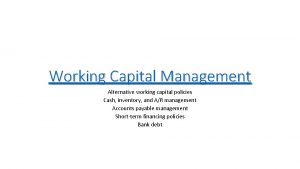Chapter 7 Working Capital Management Entrepreneurial Finance 5








































- Slides: 40

$$ $$ $$ $$ $$ Chapter 7 Working Capital Management Entrepreneurial Finance, 5 th Edition Adelman and Marks 7 - Pearson Higher Education © 2010 by Pearson Education, Inc. Upper Saddle River, NJ 07458

$$ $$ $$ $$ $$ Working Capital § Working capital consists of the current assets and the current liabilities of a business. § Current assets are gross working capital. › Cash, marketable securities, accounts receivable, and inventory § Net working capital is the difference between a business’s total current assets and its total current liabilities. § Working capital management is our ability to effectively and efficiently control current assets and current liabilities in a manner that will provide our firm with maximum return on its assets and will minimize payments for its liabilities. Entrepreneurial Finance, 5 th Edition Adelman and Marks 7 -2 Pearson Higher Education © 2010 by Pearson Education, Inc. Upper Saddle River, NJ 07458

$$ $$ $$ $$ $$ Current Asset Management § § Cash management Marketable securities management Accounts receivable management Inventory management Entrepreneurial Finance, 5 th Edition Adelman and Marks 7 -3 Pearson Higher Education © 2010 by Pearson Education, Inc. Upper Saddle River, NJ 07458

$$ $$ $$ $$ $$ Cash Management § The goal of cash management is to obtain the highest return possible on cash. Cash consists of: › Petty cash › Cash on hand › Cash in bank, checking § › Cash in bank, savings http: //www. youtube. com/watch? feature=player_detailpage&v=r 0 e. EQQNRcf 4 Entrepreneurial Finance, 5 th Edition Adelman and Marks 7 -4 Pearson Higher Education © 2010 by Pearson Education, Inc. Upper Saddle River, NJ 07458

$$ $$ $$ $$ $$ Cash Management (continued) § Float › The disbursement float is the time that elapses between payment by check and the check’s actually clearing the bank, at which point funds are removed from our checking account. › Collections float is the amount of time that elapses between your depositing a debtor’s check in your account and the check’s clearing, at which point the funds are actually placed in your account. § Managing collection float: › A lockbox is a post office box that is opened by an agent of the bank, and checks received there are immediately deposited in our account. › Electronic funds transfer (EFT) is accomplished when funds are immediately transferred from one bank account to another via computer. Pearson Higher Education Entrepreneurial Finance, 5 th Edition Adelman and Marks 7 -5 © 2010 by Pearson Education, Inc. Upper Saddle River, NJ 07458

$$ $$ $$ $$ $$ Marketable Securities Management § Marketable securities normally are those investment vehicles that include U. S. treasury bills, government and corporate bonds, and stocks. § Excess cash should be placed in the above vehicles because they increase in value more than cash itself. Entrepreneurial Finance, 5 th Edition Adelman and Marks 7 -6 Pearson Higher Education © 2010 by Pearson Education, Inc. Upper Saddle River, NJ 07458

$$ $$ $$ $$ $$ Accounts Receivable Management § The goal of accounts receivable management is to increase sales by offering credit to customers. › Options to offering credit include: – The business issuing its own credit card or line of credit. – Factoring—selling accounts receivable to another firm at a discount off of the original sales price. § The 3 C’s of credit: › A customer’s character is favorable if that customer has paid his or her bills on time in the past and has favorable credit references from other creditors. › Capacity to pay refers to whether the customer has enough cash flow or disposable income to pay back a loan or pay off a bill. › Collateral is the ability to satisfy a debt or pay a creditor by selling assets for cash. Pearson Higher Education Entrepreneurial Finance, 5 th Edition Adelman and Marks 7 -7 © 2010 by Pearson Education, Inc. Upper Saddle River, NJ 07458

$$ $$ $$ $$ $$ Accounts Receivable Management (continued) § Credit terms are the requirements that our business establishes for payment of a loan (the use of credit by a customer). › To speed up collections, cash discounts are often offered to a business customer. An example would be 2/10 net 30. If the customer pays the bill within 10 days of the invoice a 2 percent discount is given. Otherwise the entire net is due 20 days later or at the 30 th day. Entrepreneurial Finance, 5 th Edition Adelman and Marks 7 -8 Pearson Higher Education © 2010 by Pearson Education, Inc. Upper Saddle River, NJ 07458

$$ $$ $$ $$ $$ Accounts Receivable Management (continued) § Analyzing accounts receivable: › Accounts receivable turnover: › Example: › Collection days is 365 days in a year divided by accounts receivable turnover: Entrepreneurial Finance, 5 th Edition Adelman and Marks 7 -9 Pearson Higher Education © 2010 by Pearson Education, Inc. Upper Saddle River, NJ 07458

$$ $$ $$ $$ $$ Accounts Receivable Management (continued) § Use of collection days: › If collection days exceed our credit terms, then we have to speed up collections. – Example: If we give terms of 30 days and we collect in 61 days as previously shown, then we have to speed up collections in order to better manage accounts receivable. We may also have to re-evaluate our credit policies. › If collection days are less then our terms, then we have increased our liquidity. May also consider loosening credit policy. Entrepreneurial Finance, 5 th Edition Adelman and Marks 7 -10 Pearson Higher Education © 2010 by Pearson Education, Inc. Upper Saddle River, NJ 07458

$$ $$ $$ $$ $$ Accounts Receivable Management (continued) § Aging of accounts receivable is accomplished by determining the amounts of accounts receivable, the various lengths of time for which these accounts have been due, and the percentage of accounts that falls within each time frame. Entrepreneurial Finance, 5 th Edition Adelman and Marks 7 -11 Pearson Higher Education © 2010 by Pearson Education, Inc. Upper Saddle River, NJ 07458

$$ $$ $$ $$ $$ Entrepreneurial Finance, 5 th Edition Adelman and Marks 7 -12 Pearson Higher Education © 2010 by Pearson Education, Inc. Upper Saddle River, NJ 07458

$$ $$ $$ $$ $$ Inventory Management § The overall goal of inventory management is to minimize total inventory costs while maximizing customer satisfaction. § Two primary decisions must be made: › Establish the reorder quantity (the number of items to order) › Establish the reorder point (that level of inventory at which a new order will be placed). Entrepreneurial Finance, 5 th Edition Adelman and Marks 7 -13 Pearson Higher Education © 2010 by Pearson Education, Inc. Upper Saddle River, NJ 07458

$$ $$ $$ $$ $$ Inventory Management (continued) § Economic Order Quantity Formula: Ø Attempts to balance ordering costs against storage costs and provide us with the most economic quantity to order to minimize overall inventory costs. Ø Where Entrepreneurial Finance, 5 th Edition Adelman and Marks 7 -14 Pearson Higher Education © 2010 by Pearson Education, Inc. Upper Saddle River, NJ 07458

$$ $$ $$ $$ $$ Inventory Management (continued) § EOQ and Quantity Discounts › If the business is large or uses items in quantity, then quantity discounts may override the EOQ formula. We will determine this by use of both the EOQ formula previously given and the total cost formula which is: Entrepreneurial Finance, 5 th Edition Adelman and Marks 7 -15 Pearson Higher Education © 2010 by Pearson Education, Inc. Upper Saddle River, NJ 07458

$$ $$ $$ $$ $$ Inventory Management (continued) › Determining EOQ with quantity discounts requires the following procedures: – Compute EOQ for each discounted price. – If the computed EOQ falls within the discounted quantity area, then order the EOQ. – If the EOQ does not fall within the discounted quantity area, then compute total inventory costs. – Order the minimum quantity that provides the lowest overall total inventory costs. Entrepreneurial Finance, 5 th Edition Adelman and Marks 7 -16 Pearson Higher Education © 2010 by Pearson Education, Inc. Upper Saddle River, NJ 07458

$$ $$ $$ $$ $$ Entrepreneurial Finance, 5 th Edition Adelman and Marks 7 -17 Pearson Higher Education © 2010 by Pearson Education, Inc. Upper Saddle River, NJ 07458

$$ $$ $$ $$ $$ Inventory Management (continued) § Reorder Point Calculations › The reorder point (ROP) has three factors that are used in determining the quantity of an item that exists when we actually place an order: – Lead-time (L) is the time that lapses from order placement t order receipt. – Daily demand (d) is the quantity of a product that is used pe day. – Safety Stock (ss) the quantity of stock you keep for variatio in demand. Entrepreneurial Finance, 5 th Edition Adelman and Marks 7 -18 Pearson Higher Education © 2010 by Pearson Education, Inc. Upper Saddle River, NJ 07458

$$ $$ Inventory Management (continued) $$ $$ $$ § Just-in-time (JIT) is an inventory system where orders are delivered to satisfy daily, and in some cases hourly, $$ demand. It is primarily used in manufacturing. $$ › If daily demand can be accurately predicted $$ › If vendor delivery reliability is outstanding $$ › If vendors will deliver on an hourly or daily basis, then JIT $$ inventory can be used $$ $$ $$ Pearson Higher Education $$ Entrepreneurial Finance, 5 th Edition © 2010 by Pearson Education, Inc. Adelman and Marks 7 -19 Upper Saddle River, NJ 07458 $$

$$ $$ $$ $$ $$ Inventory Management (continued) § Types of inventories › Raw materials are the items that a company uses in producing its final product. › Work-in-process inventories are made up of those items that are being produced. › Finished goods inventories are made up of those items that are actually sold by the business. › Maintenance, repair, and operating (MRO) inventories are made up of those items that are used by the firm in normal operations, but are not manufactured or sold by the firm. Entrepreneurial Finance, 5 th Edition Adelman and Marks 7 -20 Pearson Higher Education © 2010 by Pearson Education, Inc. Upper Saddle River, NJ 07458

$$ $$ $$ $$ $$ Inventory Management (continued) § ABC inventory analysis is based on the 80 -20 rule or Pareto’s Law › A items: 5 to 10 percent of the inventory items (i. e. , individual stock numbers or stock keeping units) that make up approximately 75 percent of total costs › B items: 10 to 15 percent of the inventory stock numbers that make up 10 to 15 percent of the total costs › C items: The remaining 75 to 80 percent of the stock numbers account for only 10 to 15 percent of total costs (C items) Entrepreneurial Finance, 5 th Edition Adelman and Marks 7 -21 Pearson Higher Education © 2010 by Pearson Education, Inc. Upper Saddle River, NJ 07458

$$ $$ $$ $$ $$ Entrepreneurial Finance, 5 th Edition Adelman and Marks 7 -22 Pearson Higher Education © 2010 by Pearson Education, Inc. Upper Saddle River, NJ 07458

$$ $$ $$ $$ $$ Inventory Management (continued) § Determining ABC items in inventory: › Take the total quantity purchased and multiply it by the unit cost to determine total cost for the item (Table 7 -3). › Take the inventory items and list them in descending order, based on total cost (Table 7 -4). › Compute the percentage of total cost that each inventory item consumes. Entrepreneurial Finance, 5 th Edition Adelman and Marks 7 -23 Pearson Higher Education © 2010 by Pearson Education, Inc. Upper Saddle River, NJ 07458

$$ $$ $$ $$ $$ › Determine ABC by summing the percentages. Entrepreneurial Finance, 5 th Edition Adelman and Marks 7 -24 Pearson Higher Education © 2010 by Pearson Education, Inc. Upper Saddle River, NJ 07458

$$ $$ $$ $$ $$ Current Liabilities Management § Current liabilities management consists of minimizing our obligations and payments for short-term debt, accrued liabilities, and accounts payable. It consists of: › Short-term debt management › Accrued liabilities management › Accounts payable management Entrepreneurial Finance, 5 th Edition Adelman and Marks 7 -25 Pearson Higher Education © 2010 by Pearson Education, Inc. Upper Saddle River, NJ 07458

$$ $$ $$ $$ $$ Current Liabilities Management (continued) § Short-term debt management › Short-term debt consists of business obligations that will be paid within the current accounting period. They consist of the following: – Current payments on long-term debt – Bank lines of credit – Notes payable – Accounts payable – Short-term loan for one year or less Entrepreneurial Finance, 5 th Edition Adelman and Marks 7 -26 Pearson Higher Education © 2010 by Pearson Education, Inc. Upper Saddle River, NJ 07458

$$ $$ $$ $$ $$ Current Liabilities Management (continued) § Lines of credit: › A line of credit is similar to a credit card. – With it, we obtain a credit limit, but we are not obligated to make payments unless we actually borrow the money. – A line of credit is normally obtained from our primary bank. – A line of credit is used when our cash outflow exceeds our cash inflow. Entrepreneurial Finance, 5 th Edition Adelman and Marks 7 -27 Pearson Higher Education © 2010 by Pearson Education, Inc. Upper Saddle River, NJ 07458

$$ $$ $$ $$ $$ Accrued Liabilities Management (continued) § Accrued liabilities are those obligations of the firm that are accumulated during the normal course of business and are primarily payroll taxes and benefits, property taxes, and sales taxes. Entrepreneurial Finance, 5 th Edition Adelman and Marks 7 -28 Pearson Higher Education © 2010 by Pearson Education, Inc. Upper Saddle River, NJ 07458

$$ $$ $$ $$ $$ Accounts Payable Management § Accounts payable are the debts of a business which are owed to vendors. Vendors offer several types of discounts. They are: › Trade discounts › Cash discounts › Quantity discounts Entrepreneurial Finance, 5 th Edition Adelman and Marks 7 -29 Pearson Higher Education © 2010 by Pearson Education, Inc. Upper Saddle River, NJ 07458

$$ $$ $$ $$ $$ Accounts Payable Management (continued) § Trade discounts are amounts deducted from list prices of items when specific services are performed by the trade customer. › Trade discounts may be expressed as a single amount, such as 30 percent, or in a series, such as 30/20/10. Entrepreneurial Finance, 5 th Edition Adelman and Marks 7 -30 Pearson Higher Education © 2010 by Pearson Education, Inc. Upper Saddle River, NJ 07458

$$ $$ $$ $$ $$ Accounts Payable Management (continued) § Calculation of trade discounts: › Calculation of trade discounts can be accomplished by moving backward from the list price. › If list price is $300 and trade discounts are 30/20/10 then: Entrepreneurial Finance, 5 th Edition Adelman and Marks 7 -31 Pearson Higher Education © 2010 by Pearson Education, Inc. Upper Saddle River, NJ 07458

$$ $$ $$ $$ $$ Accounts Payable Management (continued) § Calculation of trade discounts (continued) › The net cost rate factor is the actual percentage of the list price paid after taking all successive trade discounts— 50. 4 percent in this case. › One minus the net cost rate factor is the single equivalent discount. Entrepreneurial Finance, 5 th Edition Adelman and Marks 7 -32 Pearson Higher Education © 2010 by Pearson Education, Inc. Upper Saddle River, NJ 07458

$$ $$ $$ $$ $$ Accounts Payable Management (continued) § Calculation of trade discounts (continued) › A second simpler way of determining the net cost rate factor and the invoice price is to multiply the complements of the trade discounts as shown below: Entrepreneurial Finance, 5 th Edition Adelman and Marks 7 -33 Pearson Higher Education © 2010 by Pearson Education, Inc. Upper Saddle River, NJ 07458

$$ $$ $$ $$ $$ Accounts Payable Management (continued) § Cash discounts are offered to credit customers to entice them to pay promptly. › The seller views a cash discount as a sales discount. › The customer views it as a purchase discount. › The terms of a cash discount play an important role in determining how the invoice will be paid. Entrepreneurial Finance, 5 th Edition Adelman and Marks 7 -34 Pearson Higher Education © 2010 by Pearson Education, Inc. Upper Saddle River, NJ 07458

$$ $$ $$ $$ $$ Accounts Payable Management (continued) § Cash discounts will normally appear on an invoice in terms such as 2/10 n 30. › This means that the customer may deduct 2 percent off of the invoice price if he or she pays within 10 days. › If the customer does not pay within 10 days, he has the use of 98% of the money owed for the next 20 days. › If the customer pays within 30 days, the net, or total amount, of the invoice is due. › If he or she pays after 30 days, the credit agreement with the seller normally stipulates that a monthly interest charge be added to the unpaid balance. Entrepreneurial Finance, 5 th Edition Adelman and Marks 7 -35 Pearson Higher Education © 2010 by Pearson Education, Inc. Upper Saddle River, NJ 07458

$$ $$ $$ $$ $$ Accounts Payable Management (continued) § Calculations used in cash discounts: › A $10, 000 invoice with terms of 2/10 n 30 › Option 1: Pay off the $10, 000 with a payment of $9, 800 within 10 days of the invoice date. – This is computed by multiplying the invoice price by 1 minus the discount (1 - 0. 02 = 0. 98, and $10, 000 x 0. 98 = $9, 800). – Or by taking the invoice price times the discount and subtracting it from the invoice price ($10, 000 x 0. 02 = $200, and $10, 000 - $200 = $9, 800). Entrepreneurial Finance, 5 th Edition Adelman and Marks 7 -36 Pearson Higher Education © 2010 by Pearson Education, Inc. Upper Saddle River, NJ 07458

$$ $$ $$ $$ $$ Accounts Payable Management (continued) § Calculations used in cash discounts (continued): › A $10, 000 invoice with terms of 2/10 n 30 › Option 2: Pay the invoice price of $10, 000 on the 30 th day after the invoice date. If this option is chosen, he will pay the equivalent of 37. 23 percent annual interest because of his delaying payment. The logic is shown on the following page. Entrepreneurial Finance, 5 th Edition Adelman and Marks 7 -37 Pearson Higher Education © 2010 by Pearson Education, Inc. Upper Saddle River, NJ 07458

$$ $$ $$ $$ $$ Accounts Payable Management (continued) § Calculations used in cash discounts (continued): › $200 is the cost paid on $9, 800 for 20 days, or an interest rate of 2. 04 percent ([$200 $9, 800] x 100). › This will result in an effective annual interest rate of 37. 23 percent (2. 04 x [365 20 days]). › The effective annual interest rate is obtained by multiplying the time period interest rate by the number of time periods in an accounting year (365 20). Entrepreneurial Finance, 5 th Edition Adelman and Marks 7 -38 Pearson Higher Education © 2010 by Pearson Education, Inc. Upper Saddle River, NJ 07458

$$ $$ $$ $$ $$ Accounts Payable Management (continued) § Quantity discounts are offered by vendors to increase their own cash flow when they offer discounts to customers who purchase items in large quantities. Entrepreneurial Finance, 5 th Edition Adelman and Marks 7 -39 Pearson Higher Education © 2010 by Pearson Education, Inc. Upper Saddle River, NJ 07458

$$ $$ $$ $$ $$ Accounts Payable Management (continued) § Cumulative discounts are normally discounts that are offered on total purchases of an item during the vendor’s fiscal year. Entrepreneurial Finance, 5 th Edition Adelman and Marks 7 -40 Pearson Higher Education © 2010 by Pearson Education, Inc. Upper Saddle River, NJ 07458
 Mpbf refers to
Mpbf refers to Fixed capital and working capital
Fixed capital and working capital Traditional management vs entrepreneurial management
Traditional management vs entrepreneurial management Operating cycle formula
Operating cycle formula What is working capital in financial management
What is working capital in financial management Gross operating cycle
Gross operating cycle Management of current assets
Management of current assets What is working capital in financial management
What is working capital in financial management Contoh kebijakan konservatif
Contoh kebijakan konservatif Mengelola keuangan
Mengelola keuangan Working smart vs working hard
Working smart vs working hard Cold working of metals
Cold working of metals Hot working and cold working difference
Hot working and cold working difference Differentiate between hot working and cold working
Differentiate between hot working and cold working Prinsip dasar proses pengerjaan panas yang benar adalah
Prinsip dasar proses pengerjaan panas yang benar adalah Ideal working capital turnover ratio
Ideal working capital turnover ratio Insufficient working capital results in
Insufficient working capital results in Factors affecting working capital requirements
Factors affecting working capital requirements Nowc formula
Nowc formula Working capital investment example
Working capital investment example Negative working capital
Negative working capital Operating net working capital formula
Operating net working capital formula Wally's
Wally's How to find change in working capital
How to find change in working capital Incremental cash flow
Incremental cash flow Working capital breakdown
Working capital breakdown Working capital life cycle
Working capital life cycle Working capital ratio
Working capital ratio Working capital
Working capital Trade working capital
Trade working capital Dell's working capital
Dell's working capital Working capital managemetn
Working capital managemetn Working capital terminology
Working capital terminology Fcfe damodaran
Fcfe damodaran Working capital reporting
Working capital reporting Hedging approach of working capital
Hedging approach of working capital Boost working capital
Boost working capital Working capital financing policy
Working capital financing policy Incremental cash flow
Incremental cash flow Tujuan manajemen modal kerja
Tujuan manajemen modal kerja Contoh manajemen modal kerja
Contoh manajemen modal kerja
